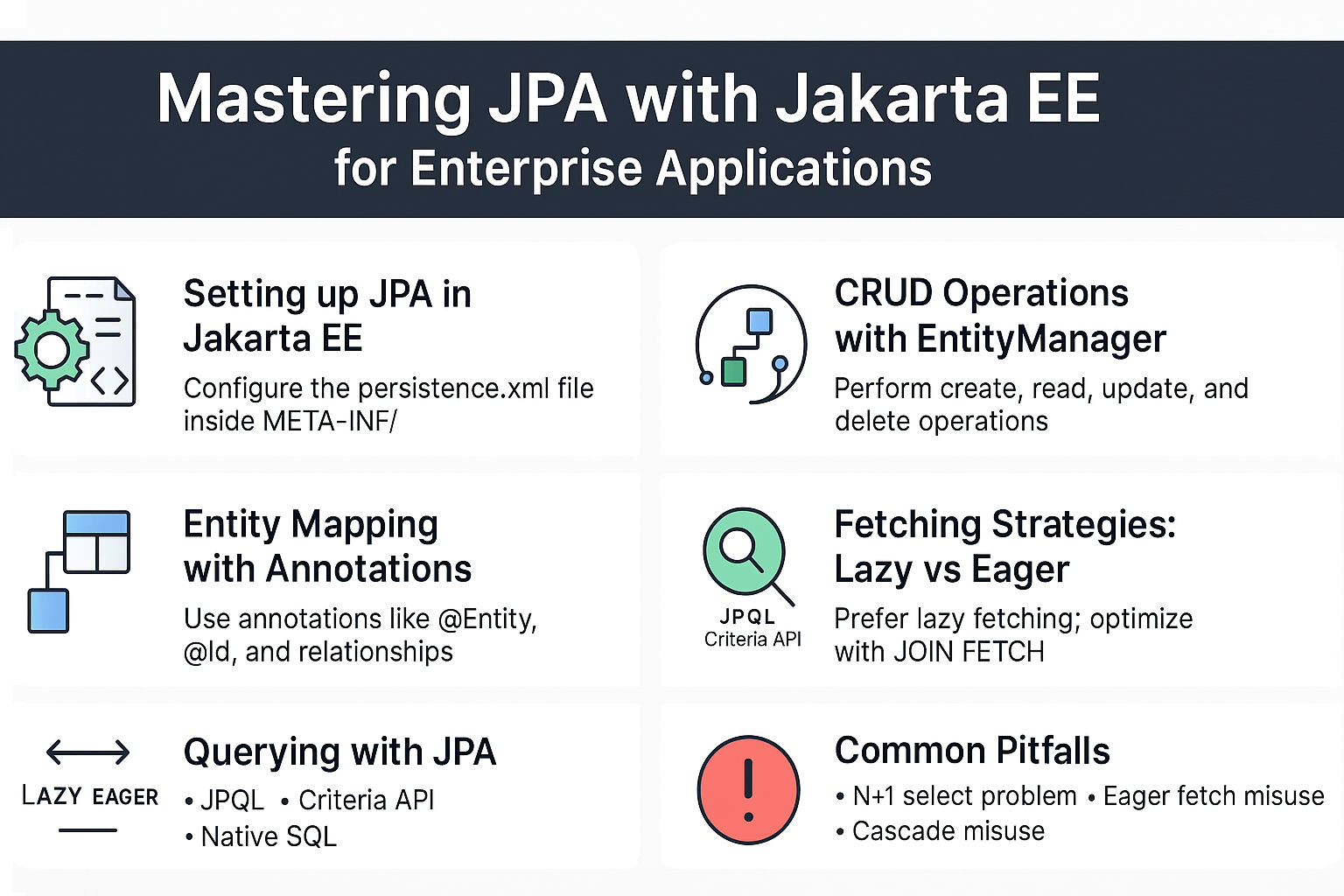Java Persistence API (JPA) is the standard Object-Relational Mapping (ORM) specification in Java that bridges the gap between relational databases and object-oriented programming. When combined with Jakarta EE (Enterprise Edition), JPA enables enterprise developers to manage persistence in scalable, secure, and transaction-aware environments.
In real-world enterprise applications, JPA simplifies data access, reduces boilerplate code, and ensures portability across database providers like Hibernate, EclipseLink, and OpenJPA. Think of JPA as a translator—it helps your Java objects communicate fluently with your database tables.
Setting up JPA in Jakarta EE
In Jakarta EE, JPA setup typically involves configuring the persistence.xml file inside META-INF/.
<persistence xmlns="https://jakarta.ee/xml/ns/persistence" version="3.0">
<persistence-unit name="examplePU" transaction-type="JTA">
<provider>org.hibernate.jpa.HibernatePersistenceProvider</provider>
<jta-data-source>java:jboss/datasources/MyDS</jta-data-source>
<properties>
<property name="jakarta.persistence.schema-generation.database.action" value="create"/>
<property name="hibernate.show_sql" value="true"/>
<property name="hibernate.format_sql" value="true"/>
</properties>
</persistence-unit>
</persistence>
Entity Mapping with Annotations
JPA uses annotations to map Java classes to database tables.
import jakarta.persistence.*;
@Entity
@Table(name = "employees")
public class Employee {
@Id
@GeneratedValue(strategy = GenerationType.IDENTITY)
private Long id;
private String name;
@ManyToOne
@JoinColumn(name = "department_id")
private Department department;
// Getters and setters
}
@Entity
@Table(name = "departments")
public class Department {
@Id
@GeneratedValue(strategy = GenerationType.IDENTITY)
private Long id;
private String name;
@OneToMany(mappedBy = "department", cascade = CascadeType.ALL)
private List<Employee> employees = new ArrayList<>();
// Getters and setters
}
Key Annotations:
@Entity: Marks a class as persistent@Table: Defines table mapping@Id: Primary key@GeneratedValue: Auto-generated primary keys@OneToMany,@ManyToOne: Relationships
CRUD Operations with EntityManager
The EntityManager is the central interface for interacting with persistence context.
import jakarta.persistence.*;
@Stateless
public class EmployeeService {
@PersistenceContext
private EntityManager em;
public void createEmployee(Employee e) {
em.persist(e);
}
public Employee findEmployee(Long id) {
return em.find(Employee.class, id);
}
public Employee updateEmployee(Employee e) {
return em.merge(e);
}
public void deleteEmployee(Long id) {
Employee e = em.find(Employee.class, id);
if (e != null) em.remove(e);
}
}
Querying with JPA
JPQL (Java Persistence Query Language)
List<Employee> employees = em.createQuery("SELECT e FROM Employee e WHERE e.department.name = :dept", Employee.class)
.setParameter("dept", "IT")
.getResultList();
Criteria API (Type-Safe Queries)
CriteriaBuilder cb = em.getCriteriaBuilder();
CriteriaQuery<Employee> cq = cb.createQuery(Employee.class);
Root<Employee> root = cq.from(Employee.class);
cq.select(root).where(cb.equal(root.get("name"), "John"));
List<Employee> results = em.createQuery(cq).getResultList();
Native SQL
List<Object[]> results = em.createNativeQuery("SELECT name, id FROM employees").getResultList();
Fetching Strategies: Lazy vs Eager
- Lazy Loading: Loads data only when accessed (like ordering food only when hungry).
- Eager Loading: Loads data immediately (like ordering everything at once).
@OneToMany(mappedBy = "department", fetch = FetchType.LAZY)
private List<Employee> employees;
Best Practice: Prefer Lazy fetching; use JOIN FETCH queries for optimization.
Real-World Use Cases
- Enterprise Apps: Manage HR systems, ERP, CRM with thousands of entities.
- Microservices: Use JPA within Jakarta EE or Spring Boot services.
- Cloud-Native Apps: Deploy with Kubernetes + Jakarta EE runtimes.
Common Pitfalls & Anti-Patterns
- N+1 Select Problem: Avoid multiple queries by using
JOIN FETCH. - Eager Fetch Misuse: Causes performance bottlenecks.
- Cascade Misuse:
CascadeType.ALLcan accidentally delete related entities.
Best Practices
- Use DTOs for transferring large data sets.
- Keep persistence unit configurations consistent across environments.
- Monitor queries with tools like Hibernate Statistics.
📌 JPA Version Notes
-
JPA 2.0
- Criteria API
- Metamodel generation
-
JPA 2.1
- Stored procedure calls
- Entity graphs
-
Jakarta Persistence (EE 9+)
- Package renamed:
javax.persistence→jakarta.persistence - Improved integration with Jakarta EE runtimes
- Package renamed:
Conclusion & Key Takeaways
- JPA simplifies persistence in enterprise apps with Jakarta EE.
- Master EntityManager, mappings, and queries for efficient ORM.
- Avoid anti-patterns like eager fetching and manage persistence context wisely.
- JPA evolves with Jakarta EE to stay relevant in modern cloud-native and microservice architectures.
FAQ
Q1: What’s the difference between JPA and Hibernate?
A: JPA is a specification; Hibernate is one of its implementations.
Q2: How does JPA handle the persistence context?
A: It’s like a classroom attendance register, keeping track of managed entities.
Q3: What are the drawbacks of eager fetching in JPA?
A: It can load unnecessary data, slowing performance.
Q4: How can I solve the N+1 select problem with JPA?
A: Use JOIN FETCH, entity graphs, or batch fetching.
Q5: Can I use JPA without Hibernate?
A: Yes, providers like EclipseLink and OpenJPA exist.
Q6: What’s the best strategy for inheritance mapping in JPA?
A: Depends on use case—SINGLE_TABLE for performance, JOINED for normalization.
Q7: How does JPA handle composite keys?
A: With @EmbeddedId or @IdClass annotations.
Q8: What changes with Jakarta Persistence?
A: Package shift to jakarta.persistence, aligning with Jakarta EE namespace.
Q9: Is JPA suitable for microservices?
A: Yes, but ensure lightweight usage with proper caching and scaling strategies.
Q10: When should I avoid using JPA?
A: For analytics-heavy workloads or when raw SQL outperforms ORM overhead.
